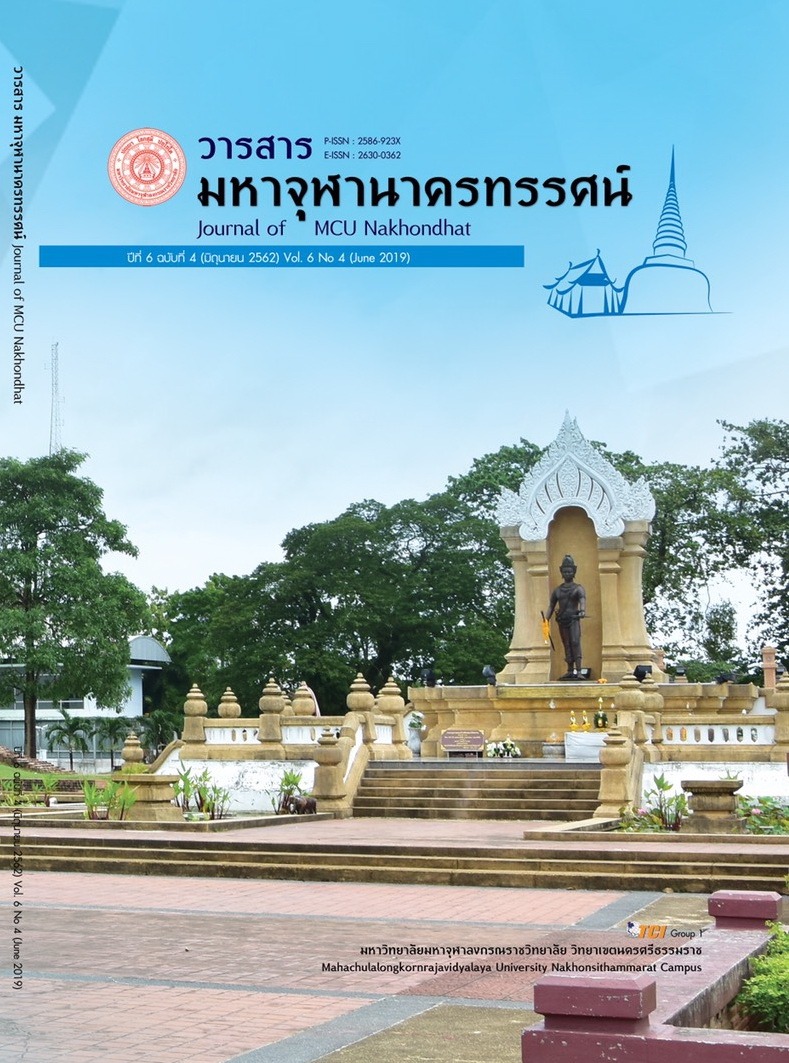THE COMPETENCY DEVELOPMENT OF THE ROYAL THAI ARMY’S CHAPLAINS BASED ON BUDDHIST INTEGRATION
Main Article Content
Abstract
The objective of this research was as follows; 1) To study the concept and theory on competency development according to modern sciences, and principle of Buddhadhamma of Thai army chaplain 2) to study the role, mission and state of problem on competency of Thai army chaplain. 3) to offer the guideline for competency development of Thai army chaplain in Buddhist integration. This is the qualitative research by studying from documents, research works, in-depth interview for 17 persons and focus group discussion for 9 persons from specialist, monks, scholars, the highest commander of chaplain and specialist chaplain for collecting reality data for analysis and synthesis respectively.
The results reveal that:
- The concept and theory on competency development according to modern sciences reveal that there are human resource development theory, theory of competency development and PDCA theory and the principle of Buddhadhamma of Thai army chaplain reveal that the principle of Tri Sikkha is the Buddhadhamma for development competency of Thai army chaplain which are composed of three competencies i.e. Physical competency (Sila), mind competency (Samadhi) and wisdom competency (Panna)
- The role and mission of Thai army chaplain, the main important are composed of four things i.e. 1) the training on moral teaching 2) Dhamma practice 3) religious ceremony performance 4) patient visiting and state of problem on competency of Thai army chaplain reveals that Physical competency is so weak, not strong as a result they are lack of efficiency on work performance, mind competency (Samadhi) reveals that there are not calm mind lack of concentration as a result it is easy to mistake and wisdom competency(Panna) reveals that they are not clear on Dhamma principle as a result they can’t explain Dhamma as well.
- The guideline for competency development of Thai army chaplain in Buddhist integration calls PACKED MODEL they are compose of P means Planning,A means Army’s goal,C means cooperation, K means kick off, E means elation, D means Dhamma i.e. 1) Iddhipada 4, 2) Brahmavihara 4, 3) Bavana 4, 4) Kallayanamittadhama7, and 5) Anusasanipathihara for integration and applying for quality of physical, mind and wisdom competency.
Article Details
How to Cite
กำใจบุญ อ. (2019). THE COMPETENCY DEVELOPMENT OF THE ROYAL THAI ARMY’S CHAPLAINS BASED ON BUDDHIST INTEGRATION. Journal of MCU Nakhondhat, 6(4), 2155–2173. retrieved from https://so03.tci-thaijo.org/index.php/JMND/article/view/186582
Section
Research Articles
References
Ivancevichj.m. (2007). Human ResourceManagement 10th ed. New yok: McGraw hill.
กองทัพบก. (2470). ตำรายุทธศาสตร์ของกรมยุทธการทหารบก. กรุงเทพมหานคร: โรงพิมพ์อรุณการพิมพ์.
กองทัพบก. (2538). คู่มือการอนุศาสนาจารย์กองทัพบก. กรุงเทพมหานคร: โรงพิมพ์กรมยุทธศึกษาทหารบก.
คงชีพ ตันตระวาณิชย์. (2543). คุณภาพชีวิตการทำงานของนายทหารชั้นประทวน สังกัดกรมทหารราบที่ 1 มหาดเล็กรักษาพระองค์. ใน วิทยานิพนธ์ศิลปศาสตรมหาบัณฑิต สาขารัฐศาสตร์. มหาวิทยาลัยเกษตรศาสตร์.
บุญยัง ศรีสมพงษ์. (2545). “การศึกษาบทบาทในการสอนธรรมของอนุศาสนาจารย์กองทัพบก”. ใน วิทยานิพนธ์พุทธศาสตรมหาบัณฑิต สาขาพระพุทธศาสนา. มหาวิทยาลัยมหาจุฬาลงกรณราชวิทยาลัย.
ปธาน ทองขุนนา. (2559). รัชกาลที่ 6 พระบาทสมเด็จพระมงกุฎเกล้าเจ้าอยู่หัว. นิตยสารยุทธโกษ, 125(1), 2.
พระพรหมคุณาภรณ์ (ป.อ.ปยุตฺโต). (2547). ลักษณะแห่งพระพุทธศาสนา. (พิมพ์ครั้งที่ 11). กรุงเทพมหานคร: เคล็ดไทย.
วิเชียร ปราบพาล. (2540). การวิเคราะห์บทบาทอนุศาสนาจารย์ : ศึกษาเฉพาะกรณีอนุศาสนาจารย์ทหารอากาศไทย. ใน สารนิพนธ์สังคมสงเคราะห์ศาสตรมหาบัณฑิต สาขาวชาการบริหารและนโยบายสวัสดิการสังคม . มหาวิทยาลัยธรรมศาสตร์.
สุจิตรา ธนานันท์. (2550). การพัฒนาทรัพยากรมนุษย์. (พิมพ์ครั้งที่ 2). กรุงเทพมหานคร: สถาบันบัณฑิตพัฒนบริหารศาสตร์.
สุทธญาณ์ โอบอ้อม. (2557). “การพัฒนาศักยภาพบุคลากรขององค์กรปกครองส่วนท้องถิ่นตามแนวพระพุทธศาสนา”. ใน วิทยานิพนธ์พุทธศาสตรดุษฎีบัณฑิต สาขาพระพุทธศาสนา. มหาวิทยาลัยมหาจุฬาลงกรณราชวิทยาลัย.
กองทัพบก. (2470). ตำรายุทธศาสตร์ของกรมยุทธการทหารบก. กรุงเทพมหานคร: โรงพิมพ์อรุณการพิมพ์.
กองทัพบก. (2538). คู่มือการอนุศาสนาจารย์กองทัพบก. กรุงเทพมหานคร: โรงพิมพ์กรมยุทธศึกษาทหารบก.
คงชีพ ตันตระวาณิชย์. (2543). คุณภาพชีวิตการทำงานของนายทหารชั้นประทวน สังกัดกรมทหารราบที่ 1 มหาดเล็กรักษาพระองค์. ใน วิทยานิพนธ์ศิลปศาสตรมหาบัณฑิต สาขารัฐศาสตร์. มหาวิทยาลัยเกษตรศาสตร์.
บุญยัง ศรีสมพงษ์. (2545). “การศึกษาบทบาทในการสอนธรรมของอนุศาสนาจารย์กองทัพบก”. ใน วิทยานิพนธ์พุทธศาสตรมหาบัณฑิต สาขาพระพุทธศาสนา. มหาวิทยาลัยมหาจุฬาลงกรณราชวิทยาลัย.
ปธาน ทองขุนนา. (2559). รัชกาลที่ 6 พระบาทสมเด็จพระมงกุฎเกล้าเจ้าอยู่หัว. นิตยสารยุทธโกษ, 125(1), 2.
พระพรหมคุณาภรณ์ (ป.อ.ปยุตฺโต). (2547). ลักษณะแห่งพระพุทธศาสนา. (พิมพ์ครั้งที่ 11). กรุงเทพมหานคร: เคล็ดไทย.
วิเชียร ปราบพาล. (2540). การวิเคราะห์บทบาทอนุศาสนาจารย์ : ศึกษาเฉพาะกรณีอนุศาสนาจารย์ทหารอากาศไทย. ใน สารนิพนธ์สังคมสงเคราะห์ศาสตรมหาบัณฑิต สาขาวชาการบริหารและนโยบายสวัสดิการสังคม . มหาวิทยาลัยธรรมศาสตร์.
สุจิตรา ธนานันท์. (2550). การพัฒนาทรัพยากรมนุษย์. (พิมพ์ครั้งที่ 2). กรุงเทพมหานคร: สถาบันบัณฑิตพัฒนบริหารศาสตร์.
สุทธญาณ์ โอบอ้อม. (2557). “การพัฒนาศักยภาพบุคลากรขององค์กรปกครองส่วนท้องถิ่นตามแนวพระพุทธศาสนา”. ใน วิทยานิพนธ์พุทธศาสตรดุษฎีบัณฑิต สาขาพระพุทธศาสนา. มหาวิทยาลัยมหาจุฬาลงกรณราชวิทยาลัย.


